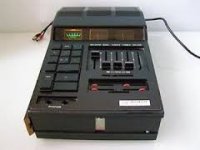I need some advice to troubleshoot the problem.
The high is missing from both channels and sounded soft and muddy when playing turntable through my integrated amp with a built-in phono stage. The same turntable sounded good with my two other integrated amps so the problem must be from the phono stage.
What could go wrong with the phono card? Do I need to replace the two L/R capacitors and the single bigger capacitor (1000 uf, at 10v). Are these 3 caps causing the problem. The amp in question is a 1980 British made Nytech receiver. CD, and tuner sound good.
I am tempted to replace the 3 caps but have no confidence that they are the cause of the problem.
The high is missing from both channels and sounded soft and muddy when playing turntable through my integrated amp with a built-in phono stage. The same turntable sounded good with my two other integrated amps so the problem must be from the phono stage.
What could go wrong with the phono card? Do I need to replace the two L/R capacitors and the single bigger capacitor (1000 uf, at 10v). Are these 3 caps causing the problem. The amp in question is a 1980 British made Nytech receiver. CD, and tuner sound good.
I am tempted to replace the 3 caps but have no confidence that they are the cause of the problem.
Hi, if you can try to draw a schematic ...
Since you have to access the down side of the PCB, to solder or de-solder...
You are referring to some caps but an active stage
( like a phono amp) has more parts; of course you can put new caps, and
you can use higher voltage ones if you don't have the same exact voltage.
I did a restoration on an old amplifier with a 1 transistor phono stage from the early '70s
and I ended subsituting the output cap of the phono stage; it was an Elna 0.47 uF/50 V
and I put an Ero MKT ( the green ones) 0.47/63 V
Since you have to access the down side of the PCB, to solder or de-solder...
You are referring to some caps but an active stage
( like a phono amp) has more parts; of course you can put new caps, and
you can use higher voltage ones if you don't have the same exact voltage.
I did a restoration on an old amplifier with a 1 transistor phono stage from the early '70s
and I ended subsituting the output cap of the phono stage; it was an Elna 0.47 uF/50 V
and I put an Ero MKT ( the green ones) 0.47/63 V
Last edited:
I will try to take a photo of the phono card the next time I open up the receiver. It is quite a challenge to open up the casing. Here is the receiver in question.
I am wondering do these caps of the phono card affect the high or low if they are faulty.
An externally hosted image should be here but it was not working when we last tested it.
I am wondering do these caps of the phono card affect the high or low if they are faulty.
Is that a receiver ? Very strange -I don't see the scale for the tuning frequencies- does
it have an electronic display ? All the buttons suggest that it's more than just an integrated amplifier .
So as you say, you have to open it again.
Oh! I made an error: my phono pre has 2 transistors
So I see : 10 uF/10 V input caps; mica precision caps in the Riaa network ( equalization ) which works by adding NFB taken after the 0.47 uF output cap, which I changed. A 100 uF cap is for supply decoupling.
it have an electronic display ? All the buttons suggest that it's more than just an integrated amplifier .
So as you say, you have to open it again.
Oh! I made an error: my phono pre has 2 transistors
So I see : 10 uF/10 V input caps; mica precision caps in the Riaa network ( equalization ) which works by adding NFB taken after the 0.47 uF output cap, which I changed. A 100 uF cap is for supply decoupling.
Nytech CTA-252 XD ??
I think it is the CTA252XD - go to product list about
http://www.pinkfishmedia.net/forum/showthread.php?t=107603
Nytech Audio / Ion Systems Appreciation Thread [Archive] - pink fish media
and look also here:
Ugliest Receiver Made - AudioKarma.org Home Audio Stereo Discussion Forums
check additional this thread:
Nytech Audio / Ion Systems Appreciation Thread - Page 13 - pink fish media
Nytech CTA-252 XD II... MC haut gain... • LS3/5a le forum
All electrolytic caps in the signal pad you must replace. Don't use 10V, use in general 63V for lower ESR. Additional use bypass caps like WIMA MKP and if space an issue, MKS.
I need some advice to troubleshoot the problem.
The high is missing from both channels and sounded soft and muddy when playing turntable through my integrated amp with a built-in phono stage. The same turntable sounded good with my two other integrated amps so the problem must be from the phono stage.
What could go wrong with the phono card? Do I need to replace the two L/R capacitors and the single bigger capacitor (1000 uf, at 10v). Are these 3 caps causing the problem. The amp in question is a 1980 British made Nytech receiver. CD, and tuner sound good.
I am tempted to replace the 3 caps but have no confidence that they are the cause of the problem.
I think it is the CTA252XD - go to product list about
http://www.pinkfishmedia.net/forum/showthread.php?t=107603
Nytech Audio / Ion Systems Appreciation Thread [Archive] - pink fish media
and look also here:
Ugliest Receiver Made - AudioKarma.org Home Audio Stereo Discussion Forums
check additional this thread:
Nytech Audio / Ion Systems Appreciation Thread - Page 13 - pink fish media
Nytech CTA-252 XD II... MC haut gain... • LS3/5a le forum
All electrolytic caps in the signal pad you must replace. Don't use 10V, use in general 63V for lower ESR. Additional use bypass caps like WIMA MKP and if space an issue, MKS.
Attachments
Last edited:
Both channels affected suggests to me that this is not a "hard" fault as such. Is there any user (or factory option) adjustable components to match the cartridge. Or has someone been there before and attempted this.
Is there an obvious audible problem or just a "subjective" feeling that it sounds a little soft ?
Is there an obvious audible problem or just a "subjective" feeling that it sounds a little soft ?
Is that a receiver ? Very strange -I don't see the scale for the tuning frequencies- does
it have an electronic display ? All the buttons suggest that it's more than just an integrated amplifier .
So as you say, you have to open it again.
Oh! I made an error: my phono pre has 2 transistors
So I see : 10 uF/10 V input caps; mica precision caps in the Riaa network ( equalization ) which works by adding NFB taken after the 0.47 uF output cap, which I changed. A 100 uF cap is for supply decoupling.
The tuning is at the bottom of the sliders. The electronic display is right at the top with the 3 little windows.
I am attaching the photos of the phono card. The larger cap is 1000 uf 16v and the two smaller caps are rated 47 uf 16v.
I am hoping that it is the caps that is causing the problem.
I think it is the CTA252XD - go to product list about
Nytech Audio / Ion Systems Appreciation Thread - pink fish media
Nytech Audio / Ion Systems Appreciation Thread [Archive] - pink fish media
and look also here:
Ugliest Receiver Made - AudioKarma.org Home Audio Stereo Discussion Forums
check additional this thread:
Nytech Audio / Ion Systems Appreciation Thread - Page 13 - pink fish media
Nytech CTA-252 XD II... MC haut gain... • LS3/5a le forum
All electrolytic caps in the signal pad you must replace. Don't use 10V, use in general 63V for lower ESR. Additional use bypass caps like WIMA MKP and if space an issue, MKS.
Thank you for the link. I have posted the problem to pinkfishmedia and hopefully, someone there could help.
I have posted more pictures of the phono cards.
I remove the casing and here are the photos.
This photo shows the phono card assembly
This photo shows the phono card
This photo show the top and bottom halves of the circuit boards
This photo show the Nytech CTA252XD receiver
This photo shows the phono card assembly
An externally hosted image should be here but it was not working when we last tested it.
This photo shows the phono card
An externally hosted image should be here but it was not working when we last tested it.
This photo show the top and bottom halves of the circuit boards
An externally hosted image should be here but it was not working when we last tested it.
This photo show the Nytech CTA252XD receiver
An externally hosted image should be here but it was not working when we last tested it.
have you tried with another pickup ?
No! I have only one turntable. I tried adding a earth connection to the Nytech (there is no earth connection for the Nytech) to the turntable earth connection. The problem still persist.
Any chance at all you may be running a MM cart into a MC loaded input?
It is a MM board and my cartridge is MM too. The phono stage was working fine the last time.
or may an out-board cheap phono-stage be your easy solution
The Nytech has one of the best sounding phono stage. If replacing some caps could solve the problem, I would prefer this option.
If both channels are affected then only the PSU is common to both. It all looks single ended AC coupled. The big cap will be rail decoupling for the phono stage. Is the rail voltage OK ? You have to start somewhere 
A cap failure in one channel wouldn't affect the other. The tantalum caps are prone to failure but all I have said before still applies.
The definitive test is to put a scope and signal generator on the phone stage (with an inverse RIAA network) and see what the response actually is.
A cap failure in one channel wouldn't affect the other. The tantalum caps are prone to failure but all I have said before still applies.
The definitive test is to put a scope and signal generator on the phone stage (with an inverse RIAA network) and see what the response actually is.
If both channels are affected then only the PSU is common to both. It all looks single ended AC coupled. The big cap will be rail decoupling for the phono stage. Is the rail voltage OK ? You have to start somewhere
A cap failure in one channel wouldn't affect the other. The tantalum caps are prone to failure but all I have said before still applies.
The definitive test is to put a scope and signal generator on the phone stage (with an inverse RIAA network) and see what the response actually is.
When I connect to an external CD player and playing the tuner, there is no such problem. So the problem must be with the phono stage which goes to the preamp. Since playing CD does not have the problem, it is not likely the preamp or the power amp sections are at fault.
Are you referring to the power supply unit (PSU)? Can the PSU be at fault and yet playing CD does not have the problem?
I am not trained in electronics so may have problem and knowhow using the scope. If the problem could be the faulty capacitors; the two smaller caps (47 uf 16v) and the bigger single cap (1000 uf 10v) on the phono card as shown, I could get them replaced. The point is I have no confidence that the caps are the cause of the problem.
The phono preamp is really a separate item. It is a high gain preamp in its own right. A failure of one cap on one channel on that phono board would mean that the other channel still played OK. A problem with the PSU (meaning the PSU local to the phono board, in other words the phono boards supply derived from the main PSU) would affect both channels of just the phono stage but would most likely just cause distortion rather than a change in response.
A starting point might be to measure the voltage across that large 10 volt cap. That looks like the supply (although a 10 volt supply is really low by todays standards). Could it be a shared feedback return cap for both channels for economy ? That's a strange possibility. Measure the voltage as a starting point.
Do you have a scope ????
A starting point might be to measure the voltage across that large 10 volt cap. That looks like the supply (although a 10 volt supply is really low by todays standards). Could it be a shared feedback return cap for both channels for economy ? That's a strange possibility. Measure the voltage as a starting point.
Do you have a scope ????
was the soft and muddy sound while playing turntable occurred suddenly or rather gradually with the progress of time ??
The problem occurs gradually over a period of time.
- Status
- This old topic is closed. If you want to reopen this topic, contact a moderator using the "Report Post" button.
- Home
- Source & Line
- Analogue Source
- High missing from phono stage


